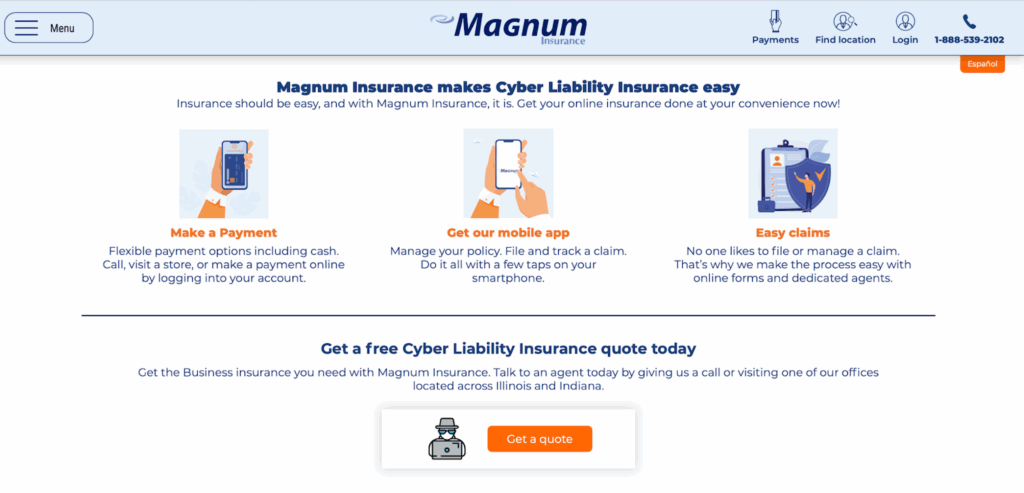
Cyber Insurance Calculator & What Algorithms Really Know About Your Business Risk
At Magnum Insurance, we’re all about making life easier and helping you save some cash. Start by using our cyber insurance calculator below – then dive in with us to learn more about how we assess your business’s cyber risk!
Cyber Insurance Calculator
Technology allows us to connect with people thousands of miles away, not to mention making worldwide trade possible! Can you even remember a time without the Internet?
The problem is, with the good usually comes the bad, and there are some nefarious folks out there. Yes, cyber attacks and malicious online activities are on the rise. In fact, a huge 67% of businesses reported a rise in cyber incidents in 2024. At the same time, the average number of attacks per organization increased from 63 in 2023 to 66 in 2024. It’s hard to get your head around why someone would do something like this, but that’s the world we currently live in.
And it can be quite scary to think about. When you consider the damage that cyber incidents can cause, it’s no wonder that businesses are looking for extra protection. After all, anything can happen at any time. It’s a concept that people often use when looking at life insurance, but the idea is the same with cyber insurance, too. After all, you don’t want all your hard work and effort wiped out by someone hiding behind a keyboard.
If you’re not sure what cyber insurance is, it helps to protect your business against the effects of cyber attacks. We’re talking about things like malware, phishing, ransomware, unauthorized access, data breaches, or even an insider threat. Any of these can cause a world of problems, not to mention lost money and potentially lost customers due to trust issues.
So how does an insurance provider like us calculate the risk level of your business? Let’s take a deep dive!
Table of Contents
- TL;DR
- The Psychology Behind How Much Your Insurance Costs
- How Does Risk Assessment Work?
- Calculators Love Regulatory Complexity!
- Boosting Your Premium Strategy
- How Magnum Insurance Simplifies Everything
- Final Thoughts
TL;DR
- No more basic questionnaires! Modern cyber insurance calculators use behavioral analytics and predictive modeling to give the best results.
- Your digital footprint, employee behavior patterns, and organizational psychology directly impact premium calculations.
- Advanced systems analyze supply chain vulnerabilities, market volatility, and economic pressures to assess risk.
- Calculators perform “data archaeology.” They do this by examining metadata, dark web intelligence, and other risk patterns.
- Operating across borders is challenging and compliance requirements create complex risk situations that affect coverage costs.
- Understanding calculator algorithms allows you to boost security investments for better premiums.
The Psychology Behind How Much Your Insurance Costs
All businesses are unique. Your business is not the same as your friend’s, and theirs is different from their neighbor’s. So, it makes sense that when you’re looking for business insurance, you need to focus on your needs, not anyone else’s. There’s no point copying what someone else does because you’re probably not going in the same direction.
That’s why you should think carefully about every part of your business before choosing the right type of insurance policy. Sure, it can be overwhelming, and honestly, we get that. Most people don’t understand insurance that well, and it’s totally understandable when you dig deeper, but Magnum Insurance is here to help you shed your confusion.
Our cyber liability insurance is designed to cover your business against the effects of cyber attacks. Of course, knowing what cyber insurance does is one thing. Choosing the right policy is quite another. Thankfully, the modern cyber insurance calculator has come a long way. They’re no longer super basic and lacking a personal touch. They take into account everything possible. Not only that, but they use the latest technology to give you the best information they can. In the end, you’ll find an answer that’s personalized to your needs, and yours alone.
The Human Factor
Technology is definitely sophisticated these days; it can do things we could only dream of just a few years ago. When you stop to think about it, there’s a little bit of technology behind almost everything we do. But it’s not so sophisticated that it still doesn’t take into account the good old human touch. This is one of the standout features of modern cyber insurance calculators. It makes sense when you think about it; while so much of business is automated, it’s human behaviors that affect decisions. For instance, technology could advise you to do one thing, but if you ignore it completely, the outcome will be different, right?
To overcome that, sophisticated cyber insurance calculators now use human behavioral patterns to measure risks that traditional methods may miss. Then, they create a detailed profile of how human behaviors and actions may contribute to cyber vulnerabilities.
Check out the table below for a little more detail on how this works:
| Human Factor Assessment Categories | Risk Indicators Analyzed | Impact on Premium |
| Password Management Behavior | Complexity adherence, reuse patterns, update frequency | 15-25% premium variance |
| Phishing Susceptibility | Training completion rates, simulation click-through rates | 20-30% premium variance |
| Social Media Exposure | Professional information sharing, personal security practices | 10-15% premium variance |
| Incident Reporting Culture | Response time, transparency levels, escalation protocols | 25-35% premium variance |
Cognitive Load Assessment
Making decisions is hard enough without having to think of a million and one ‘what ifs.’ That’s the reality of running a business, right? The problem with cybersecurity is that there are so many hidden threats that we can’t even grasp. Unless you think like a cybercriminal, how are you supposed to catch everything?
One way you can boost your chances of making strong decisions where your cybersecurity is concerned is to use cognitive load assessments. What are these? They’re a feature within modern cyber insurance calculators that carefully look at how mental tiredness and information overload affects decision-making. When you’ve got a million and one jobs to do, you’ve got one eye on the news, and you’re also trying to think of what to have for dinner, it’s easy to get overwhelmed. This affects the actions you take and the decisions you make. It can also mean that some of your choices might be … well, less than your best.
Modern calculators get this, and they use all the information they gather to create a measurable risk factor. Basically, it’s a general idea of your business’s level of risk, and from that you get a more accurate premium insurance quote. It also helps you spot any areas you can improve, which might bring down how much you end up paying.
Economic Risk Plays a Part Too
What else does a cyber insurance calculator look at? Well, microeconomic risk also comes into the equation. It’s basically a fancy term that means it also looks at any economic issues or financial problems within your whole system.
For instance, supply chain vulnerability analysis is one route. This is more on the economic side and looks at whether any relationships you have with vendors might add to your general cyber risk level. It can also look at whether any economic uncertainty and cost-cutting measures might end up giving you less protection than you need. All of this helps you find a suitable policy, meaning those malicious hackers and other cyber criminals can’t find a way past your defenses.
How Does Risk Assessment Work?

Cyber insurance calculators are one thing, but you can also use something called data archaeology. Picture Sherlock Holmes with his investigator’s hat on and imagine him looking for hidden risk from digital footprints and other data. That’s what this process is.
The best calculators don’t rely simply on questions and answers to get this information; that’s something that used to happen back in the day. These days, they do a full analysis of any accidental digital risks, and your overall security picture as it changes over time. After all, technology moves at a fast pace, and that means your risks are likely to alter a little here and there too.
This is how all types of insurance work; it’s not only cyber insurance that needs careful thought. You also need detailed evaluation when you’re applying for general liability insurance. The idea is that it helps to protect against any operational risks that could add fuel to the fire when it comes to cyber protection. So, while some of the questions might seem a bit ‘extra,’ know that it’s just about getting the full picture.
Digital Shadow Profiling
Digital shadowing might sound like something out of the Matrix or another sci-fi movie, but it’s actually a positive tool. After all, it’s not always your security systems that boost or affect your protection against cyber threats. It’s digital exposure too. This basically means any information that could somehow be accidentally leaked or exposed. Believe us, cyber criminals love this kind of stuff. You can have the strongest systems around, but if you accidentally expose information across your platforms, your risk level skyrockets. We’re talking about things like your social media presence, and any third-party data you share.
So, while the name sounds worrying, data shadow profiling actually helps to check all of this and spot any vulnerabilities you weren’t even aware of.
The checklist below gives some useful information on how to do this:
Digital Shadow Assessment Checklist:
- Scan public business databases for exposed organizational information
- Review employee LinkedIn profiles for sensitive information disclosure
- Analyze domain registration records for security vulnerabilities
- Monitor third-party data broker listings
- Assess social media privacy settings across the organization
- Review Google search results for unintended information exposure
- Check data breach databases for historical compromises
Metadata Vulnerability Mapping
Sticking with the complex-sounding tech jargon for a minute, modern calculators also use metadata vulnerability mapping. Again, it sounds mildly terrifying, but it’s a positive tool in your kit. This simply helps to look for any hidden information that hackers could find, usually deep within any digital documents you send or general emails.
There really are no limitations to how far these people will go, and it’s not beyond reality that they’ll take a good rummage around your emails. If you send any sensitive information that way, it can make you vulnerable to threats. But the good news is that this system can spot all of that and show any security gaps you’ll need to plug.
Dark Web Intelligence Integration
Ah, the dark web. It sounds intriguing in some ways, right? Most people secretly wonder what’s lurking there, but honestly, nothing good. This is literally a very dark place where criminals of all kinds go to find information, and if any of your data is on there, you’re at risk. And yes, criminals do pay for this kind of data. But don’t panic, dark web intelligence integration is here to save the day.
This is a tool that sweeps through the dark web, looking for any of your data that might be sitting there. The hope is that there isn’t anything lurking there, and in that case, great. But if there is, it helps flag the problem so you can take steps to clean it up with a digital version of bleach. Most businesses will never even think to do this, so it’s a proactive move. Yet, it allows cyber insurance calculators to look at any extra risk levels and use them when giving you an accurate premium estimate.
Temporal Risk Patterns – Wrong Place, Wrong Time
Insurance often takes a deep dive into potential temporal risks. So, what are these? Basically, temporal risk is a technical term that means the risk that something might go wrong because it happens at the wrong time. For instance, let’s say you’re planting some flowers in your garden – easy enough, right? But if you plant them too early in the year, the frost could kill them, and if you plant them too late, they might not grow in time for summer. Here, the risk of planting them at the wrong time is a temporal risk – it’s a risk that’s caused by when you do something. It’s all about timing.
Temporal risk pattern recognition looks at how your level of risk changes over time, and also works to predict future threats. It’s not about a crystal ball; instead it looks at seasonal patterns, technology depreciation, and incident responses. It uses all of that to predict how vulnerabilities will either increase or decrease over time.
For instance, let’s imagine you’re an ecommerce business and you notice that your risk calculator score always spikes around 25% during the run-up to Black Friday. The calculator’s algorithm notices increased temporary staff levels, delayed security updates, and relaxed access controls. You’re busy! Sometimes things slip. The system will then trigger you to add extra seasonal security protocols that can reduce your annual insurance premiums because you’ve taken steps to change the situation.
Calculators Love Regulatory Complexity!
Regulations – we’ll pause while you roll your eyes. These are the bane of many a business’ life, but ultimately, they’re there to keep everything ticking along nicely. Yet, regulatory issues also play a part when you’re trying to find the best cyber insurance policy at a good price.
But guess what? Cyber insurance calculators love the challenge! While they have to comply with complex regulations across several jurisdictions, they have the power to handle it. It just makes them flex their muscles more.
Of course, if your business has a particularly complex regulatory situation, it’s very important to understand coverage options such as professional liability insurance too. A lot of the time, cyber risks often overlap with professional service delivery and data protection rules, so this extra push gives you more protection.
Handling Multi-Jurisdictional Compliance

Every region of the world has its own cybersecurity regulations. The problem is that these sometimes overlap when you trade internationally and it can cause compliance issues. Checking this is really important because if you accidentally miss one, you’re in hot water, to say the least.
Cross-Border Data Flow Risk Assessment
Data protection is a huge deal these days, but it becomes more challenging when your business jumps over borders. That’s where cross-border data flow risk assessments come in very useful. These are complex systems that look at ever-changing geopolitical relationships and data laws.
For instance, Brexit in the UK changed many laws and regulations, and UK-based businesses trading in the EU had to quickly figure it all out to avoid penalties for not complying. This type of system flags all of this and tells you what you need to comply with versus what’s not necessary. Consider it your safety net, but one that will save you a lot of time and money should something go wrong.
Industry-Specific Regulatory Deep Diving
Okay, it’s time to get specific. You know that you need cyber insurance, and it’s clear that our cyber insurance calculator should be your first go-to step. But what about individual industries?
Just like every business is unique, so is every industry, and it creates a spider’s web of complications you need to be aware of.
Deep dive into the table below to explore the risk factors and impacts associated with each main industry.
| Industry Sector | Primary Regulations | Unique Risk Factors | Premium Impact Range |
| Healthcare | HIPAA, HITECH, State Privacy Laws | Patient data sensitivity, legacy systems | 25-40% above baseline |
| Financial Services | GLBA, PCI DSS, SOX, Basel III | High-value targets, strict reporting | 30-45% above baseline |
| Manufacturing | NIST, Industry 4.0 Standards | IoT vulnerabilities, supply chain | 15-25% above baseline |
| Education | FERPA, State Student Privacy Laws | Limited budgets, diverse user base | 20-30% above baseline |
| Retail | PCI DSS, State Breach Notification | Customer data volume, seasonal risks | 18-28% above baseline |
Boosting Your Premium Strategy
You want to save money on your insurance premiums – of course you do! Everyone wants to keep some cash in their pocket, and to do that, you need to look for those sneaky areas where you can save money every month, or over the course of the year if you choose to pay annually. To do that, you need a premium optimization strategy framework. And no, it’s not as complicated as it sounds. It just helps you understand and then change the things that ultimately decide your cyber insurance cost.
It’s also about looking to bundle insurance where you might need extra protection. For instance, with commercial insurance.
So, rather than just accepting the cyber insurance calculator result as the be-all-and-end-all, you can invest in targeted security improvements to cut your premiums. At the same time, you can reduce your level of risk to show insurers that you’re 100% serious. It’s also sensible to add business interruption insurance, so you have a backup in case of any issues – let’s be honest, the universe has a habit of throwing curveballs, and this gives you another important safety net.
Dynamic Risk Reduction Feedback Loops
The first step is to understand dynamic risk feedback loops. These help you understand how cyber insurance calculators look at different risk factors. From that information, you can see where you need to invest time and money to reduce risk and ultimately your premiums too. The ‘loop’ part comes in because it’s a continuous deal, giving you a constant improvement cycle for both your security in general, and the cost of your insurance.
It can be hard to figure out how to get started, but the action plan template below gives some key insights:
Premium Optimization Action Plan Template:
Phase 1: Assessment (Weeks 1-2)
- Conduct baseline risk calculator assessment
- Identify top 5 risk factors impacting premium
- Map current security controls to calculator criteria
- Benchmark against industry peers
Phase 2: Strategic Planning (Weeks 3-4)
- Prioritize improvements by premium impact potential
- Develop budget allocation for security investments
- Create timeline for implementation phases
- Establish success metrics and KPIs
Phase 3: Implementation (Months 2-6)
- Deploy high-impact security improvements
- Document all changes for insurer communication
- Monitor risk score improvements monthly
- Adjust strategy based on calculator feedback
Phase 4: Optimization (Ongoing)
- Conduct quarterly risk assessments
- Negotiate mid-term premium adjustments
- Plan next cycle improvements
- Maintain documentation for renewal negotiations
Competitive Intelligence Integration
At the start, we mentioned that your business is different to anyone else’s. Yet, it doesn’t hurt to understand what your main competitors are up to. No, it’s not sneaky, it’s sensible! That’s where competitive intelligence integration comes in very useful.
This system compares your risk profile against your competitors, and the bonus is that it can spot opportunities to give you a competitive advantage. It then uses the information from cyber insurance calculators to position your business more favorably within your industry. And what does that have the potential to do? Lower your insurance premiums, of course!
How Magnum Insurance Simplifies Everything

Take a moment – we’ve covered a lot of information and your head might be spinning slightly. It’s fine! It’s normal to feel a little confused by any type of information; it’s one of those subjects that so many people with, but it’s also one of the most important. The good news is that we’re here to hold your hand and walk you through it all. We’re not going to make anything harder than it needs to be – life’s too short for that!
We’ve talked at length about cyber insurance calculators and how they can help you save money on your insurance, so what about us? Well, with over 40 years of experience, we’re committed to making insurance a less mysterious topic and one that you can understand and use for your own benefit. We’re a highly experienced insurance broker and we’ll search to find the best option for you, even if you’re high-risk or you have poor credit – you shouldn’t miss out!
We look for business insurance policies for everything you could possibly need, including cyber protection. As we’ve already said, we know that it can be confusing and that’s why our excellent and highly experienced agents are waiting for your call. They’re on hand to carefully look at your risk level and give you a personalized service at the best possible price. We’re also happy to offer payment flexibility, with installments and financing available.
While we might never be able to make insurance as simple as breathing, we can do everything in our power to stop you feeling stressed and overwhelmed by it. Instead, we want you to feel protected and safe, and we can do that by helping you look at your options.
With ever-increasing cyber threats seemingly lurking around every corner, it’s never been a better time to enquire about your options. After all, do you really want some unscrupulous cyber criminal ruining all your hard-earned success?
Final Thoughts
Nobody said that insurance was an easy subject. It’s up there with some of the most difficult to understand concepts, and if anyone tells you differently, they’re lying! But the good news is that there are many tools to help simplify matters and give you a clearer idea of how you can save money. Our cyber insurance calculator can do just that.
As with most things technological, these calculators have evolved massively over the years, from basic to super-sophisticated options. These can now look at human behavior, psychology, and market trends, and help you make strong decisions to boost your security level and reduce your insurance costs. So, if you’re ready to take your cyber insurance strategy and improve it beyond measure, contact Magnum Insurance today. Our experts are waiting for your call, ready to boost your cover and save you money. Alternatively, head to our website for a quote. After all, money is always better in your bank account!

Quote cyber insurance online or give us a call
- Choose the right insurance
- Business Insurance
- Business Owner’s Policy
- Commercial Auto
- Commercial Property
- General Liability
- Life Insurance
- MIA Dental Insurance
- MIA Vision Insurance
- Professional Liability
- Surety Bonds
- Workers Compensation
- Select state
- Arizona
- Illinois
- Indiana
- Nevada
- New Mexico
- Texas


